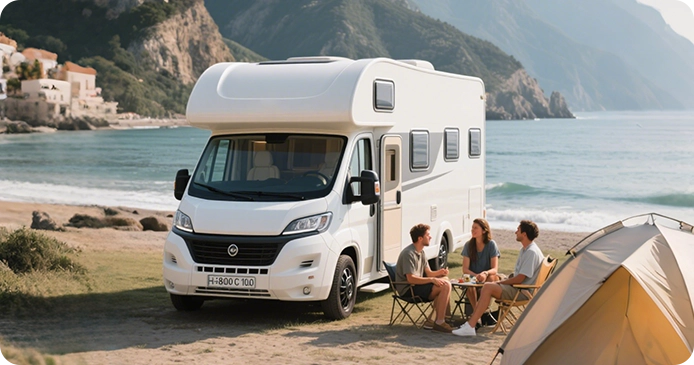Over the last few years, I’ve come to depend on lithium batteries to handle just about everything—from weekend getaways in the RV to backing up my small home solar system. One trip really stands out: I was loading up for a remote campsite in the Rockies, only to discover my old lead-acid battery had thrown in the towel after only a few hours of running a few lights and a small fan.
That headache of a trip finally pushed me to move over to a 100Ah lithium battery, and since then I’ve been a bit obsessed with learning how to get the most runtime out of it. If you’re asking yourself the same thing—“How long will a 100Ah battery actually run?”—you’re in the right spot. I’ll walk you through what I’ve figured out the hard way, so you can plan your power setup without guesswork.
What Are Ampere-Hours? Making Sense of 100Ah Battery Capacity
Let’s start with the basics, because when I first got into this, battery specs honestly felt like reading a different language. Capacity is simply the amount of electrical charge a battery can hold, measured in ampere-hours (Ah)—you can think of it like the size of a fuel tank. A 100Ah battery, on paper, can supply 100 amps for one hour or, for example, 5 amps over 20 hours before it’s fully drained.
In day-to-day use though, most of us aren’t pulling a constant 100-amp load. On my home solar setup, I run a 100Ah deep cycle battery to keep a fridge ticking over through the night.
Converting Ah into watt-hours (Wh) gives a clearer view of usable energy. You just multiply capacity by voltage (typically 12V in these systems), so 100Ah × 12V = 1,200Wh. That means the battery can theoretically provide 1,200 watts for one hour, or 100 watts for 12 hours, assuming there are no losses.
The key takeaway? Lining this up with your actual power draw helps you avoid unpleasant surprises in the middle of the night. I’ve learned that ignoring Ah figures often leads to buying the wrong battery size or coming up short on power—once you get comfortable with ampere-hours, you’re well on your way to predictable runtime.
Which 100Ah Battery Type Fits You Best? A Practical Comparison
Picking the right 100Ah battery chemistry can completely change your experience. My old 100Ah AGM unit was easy on the wallet but heavy and limited; it let me down on a rainy RV weekend. Here’s how the main 100Ah battery types compare:
Lead-Acid: Cost-effective, typically 55–65 lbs, with a 50% depth of discharge (DoD), so only half of its rated capacity is realistically usable. Offers around 300–500 cycles and suits occasional applications like backup power for vehicles or UPS systems.
Lithium-Ion: Much lighter (about 20–25 lbs), 80% DoD, and roughly 3,000–5,000 cycles in many designs. Often built with nickel-manganese-cobalt (NMC) cathodes for higher energy density, making them popular in compact gear such as e-bikes or portable devices.
LiFePO4: Generally 25–30 lbs, up to 100% DoD, and around 2,000–5,000 cycles. The iron phosphate cathode improves thermal stability, which boosts safety and makes it a strong choice for daily use in solar systems, RVs, and marine installations.
LiFePO4’s ability to tolerate deep discharges and operate in colder conditions (-4°F to 140°F) kept my kit running on a winter van trip across the Prairies. The underlying chemistry is important: most lithium batteries use a carbon-based anode and lithium salt electrolyte, while the cathode (NMC vs LiFePO4) shapes the performance. NMC is often used where maximum energy density is needed, like in EVs, while LiFePO4 leans toward long life and safety. Here’s a side-by-side look:
Battery Type
Weight (lbs)
Usable Capacity (% DoD)
Cycle Life
Safety Features
Best For
100Ah AGM (Lead-Acid)
55-65
50%
300-500
Needs ventilation (H2 gas risk)
Automotive, UPS
100Ah Lithium-Ion
20-25
80%
500-1,000
Risk of thermal runaway if damaged
E-bikes, electronics
100Ah LiFePO4
25-30
100%
2,000-5,000
Thermally stable, no fire risk
Solar, RVs, marine
After weighing everything up, I went with a 100Ah LiFePO4 battery because it combines long service life with a strong safety profile.
Step-by-Step: Working Out How Long a 100Ah Battery Will Run in Your System
Now for the hands-on part: doing the runtime calculations. The first time I properly worked this out was during a power cut, scribbling numbers on the back of a receipt—it turned a stressful night into a manageable one. To estimate how long a 100Ah battery will last, start with its theoretical energy: 100Ah × 12V = 1,200Wh.
Then factor in depth of discharge (DoD)—a lead-acid battery at 50% DoD offers about 600Wh of usable energy, while a 100Ah LiFePO4 can realistically use the full 1,200Wh. Next, consider inverter efficiency (often 90–95% when you convert to AC for most household devices) and small losses in cabling or the battery management system (BMS), usually around 2–5%. For LiFePO4, that often works out to roughly 1,080Wh usable (1,200Wh × 0.90).
From there, divide by your total load: Runtime (hours) = Net Wh ÷ Watts. Running a 100W fan? You’re looking at about 10.8 hours. I often use free online amp-hour calculators to confirm my math when I’m planning trips.
One practical tip from my own use: Add about 10% to your estimated load to cover extras like chargers, standby devices, or an extra light you forget about. This approach isn’t just theory—it’s what kept my cabin powered through a three-day prairie storm.
Key Real-World Factors That Affect 100Ah Battery Runtime
Even with good calculations, real-life performance can still shift. On a long RV drive across Canada, I watched my 100Ah lithium battery drain more quickly than expected in hot weather, which reminded me how much conditions matter.
Your connected load has the biggest influence—higher-power devices (like a 500W microwave) dramatically shorten runtime, while low-power LEDs make it last. The discharge rate, or C-rate, plays a role as well: a 1C discharge empties the battery in about an hour at full draw; push it to 2C and runtime is cut in half. LiFePO4 batteries can usually handle higher C-rates (3C–5C) more comfortably than lead-acid, which prefers gentler 0.2C loads.
Battery age and wear gradually reduce capacity—after around 500 cycles, you might see a 10–20% loss if the battery hasn’t been treated kindly. Self-discharge is another factor: lead-acid batteries can lose about 4% of their charge each week in storage, whereas LiFePO4 typically only loses 2–3% per month.
Temperature is a big one for Canadian conditions—below about 14°F, available output can drop significantly, although my Vatrer low-temp cutoff battery models add protective features to help manage the cold. Moisture, vibration from rough roads, and dust can also contribute to wear, which is why I’ve gotten into the habit of checking status through a BMS app. Paying attention to these details will help you set realistic expectations.
How Long a 100Ah Battery Can Last in Everyday Use
This is where the numbers meet actual experience. For lighter loads—like a 20W router during a power outage—my 100Ah LiFePO4 battery has carried on for more than 50 hours, which is plenty for streaming and staying connected.
On medium loads, such as a 500W fridge in a small off-grid cabin, I see roughly 2 hours of operation from a fully charged 100Ah pack. When I’m running high-demand tools, it’s a different story: a 2,000W power tool might only get around half an hour, which is why I scale up capacity for any serious workshop setup.
In the RV, a typical evening might involve a 10W light, a 50W TV, and a 30W fan—about 90W in total—giving me around 12 hours of runtime, which is more than enough for an evening of TV and a comfortable night.
For golf carts, runtime really depends on terrain: on relatively flat paths, you might get around 8 hours at a 10A draw, while hilly routes can cut that down to about 4 hours. On the water, I’ve wired four 12V 100Ah batteries in parallel, giving enough capacity to run a 100W boat load for up to 48 hours.
These aren’t just theoretical numbers—they’re drawn from actual trips and projects. To make it easier to picture, here’s a quick runtime snapshot for a 100Ah LiFePO4 battery (net 1,080Wh):
Load Example
Total Watts
Estimated Hours
Router + LED Lights
30
36
Fridge
500
2.2
TV + Fan
100
10.8
Power Tool Burst
2,000
0.5
Using a table like this makes it much easier to plan your next road trip, cabin stay, or weekend on the lake.
How to Extend the Life and Runtime of Your 100Ah Battery
Knowing how long a battery can last is useful; learning how to stretch that runtime and lifespan is even better. After damaging one battery by letting it run far too low on a solo hiking trip, I changed my habits—and it’s made a real difference.
Start by pairing your battery with a charger that’s designed for its chemistry and BMS; LiFePO4 batteries, for instance, perform best with a charge profile around 14.6V. Try not to run them flat unnecessarily—keep within the recommended depth of discharge range (often 80–100% usable for lithium, less for lead-acid), and store your batteries at moderate temperatures, ideally around 50–77°F, to reduce self-discharge and stress.
Clean terminals every few months, especially if you’re camping in dusty areas or near the coast. For any remaining lead-acid batteries in your shed, remember to top up with distilled water when needed and ensure good ventilation.
With lithium batteries, Bluetooth-enabled monitoring (like I use with my Vatrer Battery) helps you spot issues before they become serious. When it’s time to retire a pack, drop it at a proper recycling facility; most communities across Canada have designated centres for handling lithium safely. These simple practices have effectively doubled the useful life I get from my batteries.
Plan Ahead for Consistent Power from Your 100Ah Battery
In the end, working out how many hours you can get from a 100Ah battery really comes down to understanding capacity, your load, and a few smart adjustments—whether you’re powering a weekend RV escape, a lakeside cabin, or a small solar system at home.
From my early missteps to more reliable setups, LiFePO4 has proven to be the most dependable option, thanks to its deep discharge capability and high cycle life compared with traditional lead-acid batteries.
If you’re getting ready to upgrade, take a look at the Vatrer 100Ah battery. Its built-in low-temperature cutoff, self-heating function, IP65 water-resistance, and Bluetooth monitoring make it well suited to cold mornings on the prairies or wet trails on the West Coast. The price remains reasonable while still offering more than 5,000 cycles and 100A BMS protection. It’s the setup that kept my last trip lit right through until sunrise.
FAQs
How Long Does It Take to Charge a 100Ah Battery with a 200W Solar Panel?
The charging time depends on the battery chemistry, the true output of the solar panel, and local conditions. For a 100Ah LiFePO4 battery (12V, about 1,200Wh capacity), a 200W solar panel will deliver less than its rated power once you account for efficiency losses—typically 15–20% from panel efficiency, the charge controller, and cabling. If we assume around 160W usable (200W × 0.8) and roughly 6 hours of strong sun per day:
Calculation: Charging time = Battery Capacity (Wh) ÷ Effective Solar Power (W) = 1,200Wh ÷ 160W ≈ 7.5 hours under ideal, clear conditions.
Real-World Adjustment: Cloud cover, shading, or panels not angled directly at the sun can stretch this to 10–12 hours, which often means one to two days in mixed weather.
Using a good MPPT charge controller will help you capture more of the available solar energy. If you want quicker charging, you can step up to a 300W array or combine solar with a 10A AC charger (which typically takes around 10 hours). Keep the panels clean and angled toward the sun to maintain output. At my off-grid cabin, a 200W panel with an MPPT controller usually brings my Vatrer 100Ah battery from low to full in roughly 8 hours on bright, clear days.
How Long Will a 100Ah Battery Run a Trolling Motor?
The trolling motor’s runtime on a 100Ah battery is based on how much power the motor draws. Many smaller and mid-sized motors (30–55 lbs of thrust) use between about 300–600W. With a 100Ah LiFePO4 battery (around 1,200Wh, and roughly 1,080Wh net after typical system losses):
300W Motor: 1,080Wh ÷ 300W ≈ 3.6 hours at full speed.
600W Motor: 1,080Wh ÷ 600W ≈ 1.8 hours.
Real-World Use: In practice, most anglers don’t run full throttle all the time. At about half power (roughly 150W on a 300W motor), you could see around 7.2 hours of use.
A LiFePO4 battery is well suited here because its 100% depth of discharge (DoD) provides more usable energy than a lead-acid battery, which is generally limited to about 50% DoD. Keep an eye on consumption with a BMS app so you don’t over-discharge. For longer days on the water, I pair a single Vatrer 100Ah battery with a second one in parallel, giving roughly 2,400Wh and stretching runtime to about 7–14 hours at a 300W draw. Regularly check the motor and propeller for weeds or debris to keep power use in check.
How Many Watts Is a 100Ah Battery?
A 100Ah battery’s energy is expressed in watt-hours (Wh), rather than watts. Watts measure the rate of power use, while watt-hours tell you how much energy is stored. For a 100Ah battery at 12V:
Calculation: Wh = Ah × Voltage = 100Ah × 12V = 1,200Wh.
Usable Capacity: With LiFePO4 (100% DoD), you can use up to the full 1,200Wh; with lead-acid (around 50% DoD), it’s closer to 600Wh. After factoring in inverter efficiency (roughly 85–95%), a 100Ah LiFePO4 battery typically delivers around 1,020–1,140Wh to your loads.
In simple terms, that’s enough to run a 100W device for roughly 10–11 hours, or a 1,000W device for around 1 hour. Always check the watt rating on your gear and compare it to your battery’s Wh capacity. For mixed loads, a plug-in watt meter makes it easier to see how much you’re actually using. I rely on this approach in my RV to keep total consumption within what my 100Ah battery can comfortably handle.
How Do I Size a 100Ah Battery System for My Solar Setup?
To properly size a 100Ah battery for solar, you’ll want to look at your daily energy demand and the amount of sunlight you typically get. A 100Ah LiFePO4 battery holds about 1,200Wh (roughly 1,080Wh usable after system losses). Start by estimating your load—for example, a 500W fridge running 4 hours a day uses about 2,000Wh daily.
One 100Ah Battery: Provides around 1,080Wh/day, which falls short of 2,000Wh.
In that case, you’d need at least two 100Ah batteries in parallel (for about 2,400Wh) to comfortably cover your usage. Pair them with roughly 400W of solar (which can recharge around 2,400Wh in 6–8 hours of good sunlight) and a quality MPPT controller. At my own off-grid cabin, I run two Vatrer 100Ah batteries and a 400W panel, which covers lighting, a fridge, and a fan day after day. Always total your appliance wattages and add an extra 20% to allow for inefficiencies and cloudy days.
What Should I Do If My 100Ah Battery Isn't Lasting as Expected?
If your 100Ah battery is running down faster than the numbers suggest, a bit of troubleshooting usually reveals why:
High Load: Confirm the wattage of your devices with a watt meter; some appliances draw more than their labels suggest, or have start-up surges that shorten runtime.
Battery Health: Check open-circuit voltage or BMS information. After several hundred cycles, capacity can drop, especially if the battery has been frequently over-discharged.
Charging Issues: Make sure your charger profile matches the battery (for LiFePO4, a charge voltage around 14.6V is typical). Slow or incomplete charging may mean a failing charger or insufficient solar input.
Environmental Factors: Extreme cold (below about 14°F) or high heat (above about 104°F) can reduce performance. Using insulated enclosures or low-temperature-rated batteries helps.
Test the battery with a simple, known load (for example, a 100W light) to see if the measured runtime matches expectations. If not, the battery or charger may be at fault. I once restored proper runtime on my solar system by replacing an old, underperforming charger. Upgrading to a BMS-monitored battery like Vatrer’s 100Ah model also gives you Bluetooth diagnostics, making it easier to see what’s going on in real time.
























































